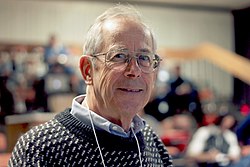Jim Peebles
Phillip James Edwin Peebles | |
|---|---|
 | |
| Born | April 25, 1935 Winnipeg, Manitoba, Canada |
| Alma mater | University of Manitoba (BSc) Princeton University (PhD) |
| Known for | Cosmic microwave background radiation |
| Awards | Eddington Medal (1981) Heineman Prize (1982) Bruce Medal (1995) Gold Medal of the Royal Astronomical Society (1998) Gruber Prize (2000) Harvey Prize (2001) Shaw Prize (2004) Crafoord Prize (2005) Dirac Medal (2013) |
| Scientific career | |
| Fields | Theoretical physics Physical cosmology |
| Institutions | Princeton University |
Phillip James Edwin Peebles (born April 25, 1935) is a Canadian-American physicist and theoretical cosmologist who is currently the Albert Einstein Professor Emeritus of Science at Princeton University.[1][2] He is widely regarded as one of the world's leading theoretical cosmologists in the period since 1970, with major theoretical contributions to primordial nucleosynthesis, dark matter, the cosmic microwave background and structure formation. His three textbooks (Physical Cosmology, 1971; Large Scale Structure of the Universe, 1980; Principles of Physical Cosmology, 1993) have been standard references in the field.
Academic career
Peebles was born in Winnipeg and completed his bachelor's degree at the University of Manitoba. He left Manitoba in the fall of 1958 to attend Princeton University, where he completed his doctorate supervised by Robert Dicke;[3] he remained at Princeton for his whole career.
Peebles has made many important contributions to the big bang model. With Robert Dicke and others (nearly two decades after George Gamov, Ralph A. Alpher and Robert C. Herman), he predicted the cosmic microwave background radiation. Along with making major contributions to big bang nucleosynthesis, dark matter and dark energy, he was the leading pioneer in the theory of cosmic structure formation in the 1970s. Long before it was considered a serious, quantitative branch of physics, Peebles was studying physical cosmology and has done much to establish its respectability. His Shaw Prize citation states "He laid the foundations for almost all modern investigations in cosmology, both theoretical and observational, transforming a highly speculative field into a precision science." [4]
Peebles has a long record of innovative idea, introducing the basic idea, which were extensively studied latter by others scientists. For instance, in 1987, proposed the primordial isocurvature baryon model for the development of the early universe.[5]
Honours
Awards
- Eddington Medal (1981)
- Heineman Prize (1982)
- Henry Norris Russell Lectureship (1993)
- Bruce Medal (1995)
- Oskar Klein Medal (1997)
- Gold Medal of the Royal Astronomical Society (1998)
- Gruber Prize in Cosmology (2000), with Allan Sandage
- Harvey Prize (2001)
- Shaw Prize (2004)
- Crafoord Prize with James E. Gunn and Martin Rees (2005)
- Hitchcock Professorship (2006)
- Dirac Medal (2013)
Named after him
- Asteroid 18242 Peebles
References
- arXiv:astro-ph/0207347 B. Ratra and P. J. E. Peebles, "The cosmological constant and dark energy", Rev. Mod. Phys. 75, 559 (2003).
- arXiv:astro-ph/9712020 M. Fukugita, C. J. Hogan and P. J. E. Peebles, "The cosmic baryon budget", Astrophys. J. '503, 518 (1998).
- P. J. E. Peebles, Principles of Physical Cosmology (Princeton University Press, Princeton, 1993).
- B. Ratra and P. J. E. Peebles, "Cosmology with a time-variable cosmological 'constant'", Astrophys. J. 325, L17 (1988).
- B. Ratra and P. J. E. Peebles, "Cosmological consequences of a rolling homogeneous scalar field", Phys. Rev. D 37, 3406 (1988).
- M. Davis and P. J. E. Peebles, "A survey of galaxy redshifts. V – The two-point position and velocity correlations", Astrophys. J. 267, 465 (1983).
- P. J. E. Peebles, "Large-scale background temperature and mass fluctuations due to scale-invariant primeval perturbations", Astrophys. J. 263, L1 (1982).
- P. J. E. Peebles, The large-scale structure of the universe (Princeton University Press, Princeton, 1980).
- E. J. Groth and P. J. E. Peebles, "Statistical Analysis Of Catalogs Of Extragalactic Objects. 7. Two And Three Point Correlation Functions For The High-Resolution Shane-Wirtanen Catalog Of Galaxies", Astrophys. J. 217, 385 (1977).
- J. P. Ostriker and P. J. E. Peebles, "A Numerical Study of the Stability of Flattened Galaxies: or, can Cold Galaxies Survive?", Astrophys. J. 186, 467 (1973).
- P. J. E. Peebles, Physical Cosmology, (Princeton University Press, Princeton, 1971).
- P. J. E. Peebles and J. T. Yu, "Primeval adiabatic perturbation in an expanding universe", Astrophys. J. 162, 815 (1970).
- P. J. E. Peebles, "Origin of the Angular Momentum of Galaxies", Astrophys. J. 155, 393 (1969).
- P. J. E. Peebles and R. H. Dicke, "Origin of the Globular Star Clusters", Astrophys. J. 154, 891 (1968).
- P. J. E. Peebles, "Primordial Helium Abundance and the Primordial Fireball. II", Astrophys. J. 146, 542 (1966).
- P. J. E. Peebles, "Primordial Helium Abundance and the Primordial Fireball. I", Phys. Rev. Lett. 16, 410 (1966).
- R. H. Dicke, P. J. E. Peebles, P. G. Roll and D. T. Wilkinson, "Cosmic Black-Body Radiation", Astrophys. J. 142, 414 (1965).
Footnotes
- ^ Princeton University Physics Department
- ^ Princeton University News
- ^ Seeing Cosmology Grow
- ^ . Shaw Foundation http://www.shawprize.org/en/shaw.php?tmp=3&twoid=53&threeid=67&fourid=123. Retrieved January 27, 2016.
{{cite web}}: Missing or empty|title=(help) - ^ Hu (1994-06-28)
Bibliography
- Hu, Wayne (June 28, 1994). "The Nature versus Nurture of Anisotropies". arXiv:astro-ph/9406071.
{{cite arXiv}}:|class=ignored (help)
External links
- 1935 births
- Members of the United States National Academy of Sciences
- Living people
- Canadian scientists
- American people of Canadian descent
- People from Winnipeg
- American astronomers
- Cosmologists
- Princeton University alumni, 1960–69
- Princeton University faculty
- University of Manitoba alumni
- Recipients of the Gold Medal of the Royal Astronomical Society
- 21st-century astronomers
- 20th-century astronomers
- Winners of the Dannie Heineman Prize for Astrophysics
